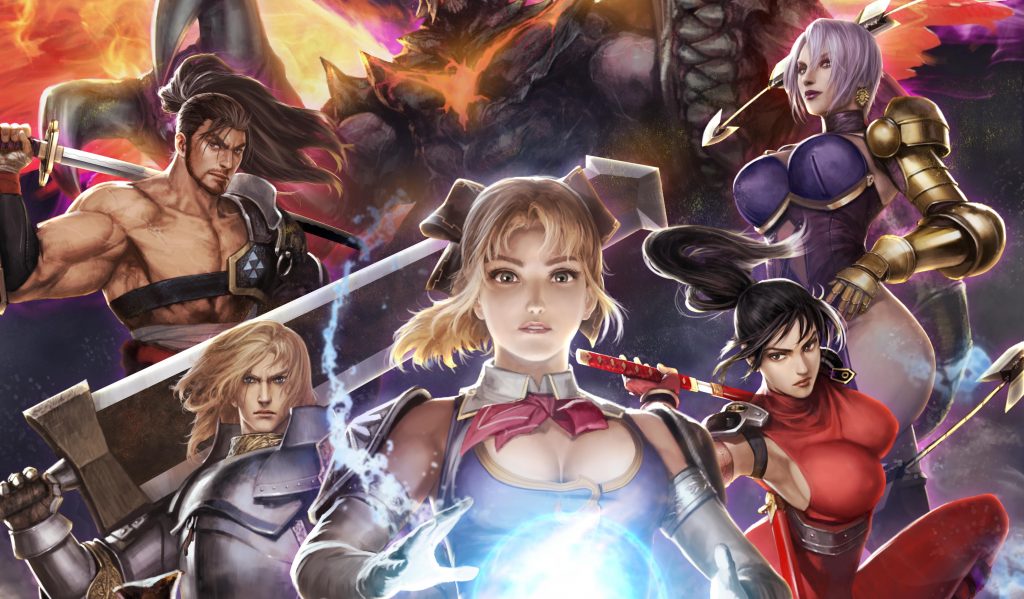Remembering the App Store classics that are sadly no longer with us; welcome back to the stage of history.
Before Soulcalibur became Soulcalibur it was called Soul Blade (or in Japan, Soul Edge). It was released on the PlayStation in Japan in 1996, and the North American and European versions hit the shelves in 1997. At the time it was going head to head with the established giants of the beat-em’-up genre; Mortal Kombat, Street Fighter and Namco’s own Tekken series; which had usurped Virtua Fighter as the number one 3D beat-‘em-up. Lateral movement wasn’t included at that stage, but the camera would float around and zoom in and out to add a greater perception of depth.
Soul Blade also boasted one of the best video game intros of all time. Don’t believe us? Go check it out on YouTube. It still gives us a shiver of excitement all these years later! Unlike its predominantly martial arts-inspired rivals, Soul Blade was all about the weapons, which added another layer of depth. But it wasn’t until the sequel, Soulcalibur, appeared on the Dreamcast that the game really came out from the shadow of its competitors, and since then it’s gone from strength to strength, with the latest sequel, Soulcalibur VI, being released in 2018.
 Back in 2012, Apple gamers had the chance to go almost back to the franchise’s Dreamcast roots and experience what it was like to be smashed in the face with a giant sword, right on your iPhone or iPad. The game had most of the usual modes you’d expect from an arcade fighting title. The main mode was Arcade, where you fight your way through to a final showdown with the boss character, Inferno. Ten characters were available from the start, and new ones are unlocked by completing Arcade Mode with each fighter for a healthy final total of 19 playable characters.
Back in 2012, Apple gamers had the chance to go almost back to the franchise’s Dreamcast roots and experience what it was like to be smashed in the face with a giant sword, right on your iPhone or iPad. The game had most of the usual modes you’d expect from an arcade fighting title. The main mode was Arcade, where you fight your way through to a final showdown with the boss character, Inferno. Ten characters were available from the start, and new ones are unlocked by completing Arcade Mode with each fighter for a healthy final total of 19 playable characters.
On the Attack!
Time Attack Mode pitted you against the clock to win a set number of fights, while Survival Mode was about winning as many fights as possible with only a small health regeneration after each. The one mode that was missing was probably the most important for any one-on-one fighting game, and that was a two-player head-to-head. Gamers hoped this mode would be implemented in a future update, but alas, that never happened. It wasn’t a game-breaking flaw as there were plenty of challenges for the single player and enough characters to take players a long time to get anywhere near mastering them all.
The familiar Soulcalibur control system was recreated using a virtual stick and buttons (no PlayStation or Xbox controller compatibly back then!), and this brought with it the usual associated problems. Without the feedback of an actual stick and buttons it was hard to tell if you were inputting the commands correctly. This obviously became more of a complaint as you tried to pull off the more complex moves and combos. In fairness, the controls worked as well as they possibly could, but you never got the same level of intuitiveness, feel and fluidity you have with the traditional controllers and arcade sticks, which is how this game was originally designed to be played.

The iOS version tried to make things easier by allowing you to set up your own button configurations. You could drag the buttons anywhere you want on the screen to design a layout that felt as comfortable as possible. There was also the option of adding an additional button that can activate a combo of any of the other buttons. Some characters had moves that required two buttons to be pressed simultaneously, which could be very tricky to do, so the ability to create your own multi-button button (if you will) was very handy indeed.
Stick it to ‘Em…
For those willing to struggle with virtual stick controls, Soulcalibur was a faithful conversion of this great fighting game on your iPad or iPhone. It was a near-perfect conversion of the original, which was extremely impressive almost a decade ago. The graphics looked great. What’s more important is they moved smoothly and the game did an admirable job of keeping the frame rate high even when the action heated up.
Soulcalibur’s weapons-based combat gave it a different feel to other beat-‘em-ups, and really set it apart. You could learn each character’s moves by entering Practice Mode from where you could call up a complete list of special moves and combos, and practice them to your heart’s content. There were some crunching moves and awesome combos to be discovered.
The character roster was healthily diverse and well balanced, meaning the speedy, lightweight Xianghua can take on a lumbering behemoth such as the enormous battleaxe-wielding Astaroth. As with all fighting games, mastering a character is all about learning their strengths and weaknesses as well as the mechanics of actually executing their moves.
Technically this came as close to the original as anyone could possibly have hoped for. The touchscreen controls worked as well as could realistically be expected, the characters were all here, complete with all their moves, and graphics were tidy, fast and smooth. There was a problem with the menus, especially the in-game pause menu, particularly on the iPhone. Basically they were too small. This was not a problem on an iPad, but iPhone users would sometimes struggle to select the desired option.

The lack of a competitive Two-Player Mode was more serious because that’s what fighting games are ultimately all about. There was still plenty of fun to be had from beating seven bells out of the computer characters, but this game had one more very serious problem, and that was the price. It was nearly twice as much as the awesome Infinity Blade, and cost nearly three times as much as the blockbuster conversion of Grand Theft Auto 3. Where on Earth Namco Bandai got the idea that this was an appropriate price to charge for a conversion of a 12-year-old game was baffling. Maybe this lead to the game’s failure, and its removal from the App Store? We’ll leave you with a contradiction; this was a really good game with which we were a little disappointed, but one we would love to revisit on the contemporary iOS and iPadOS devices. The highly divisive sequel Soulcalibur Unbreakable Soul, which followed a more touchscreen friendly and vastly simplified combat engine was launched in 2014 , this sequel has also disappeared from view, albeit for more obvious reasons!


